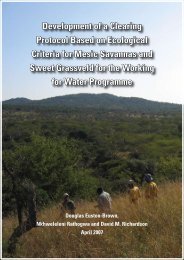INFORMATION DOCUMENT - DWA Home Page
INFORMATION DOCUMENT - DWA Home Page
INFORMATION DOCUMENT - DWA Home Page
Create successful ePaper yourself
Turn your PDF publications into a flip-book with our unique Google optimized e-Paper software.
RECORDED IMPACTS<br />
Metsi Consultants did their baseline study<br />
field work during 1999, when Katse Dam<br />
was being operated at close to Treaty<br />
minimum releases, so the results gave a<br />
good indication of the kinds of conditions<br />
which might prevail under the Treaty<br />
scenario:<br />
❏ The state of both the instream and<br />
riparian habitat (“habitat integrity”) at site<br />
2 (below Katse) was rated to be less than<br />
50% (of the ‘pristine’ condition). Other<br />
sites – not affected by a dam – got scores<br />
of between 80% and 95%.<br />
❏ Water quality at site 2 was poor, there<br />
were abundant algae in the water<br />
(mountain rivers usually flow clean) and<br />
very few fish.<br />
Monitoring downstream of Katse Dam<br />
(IFR sites 2 and 3) in summer 2000/01<br />
and summer 2001/02 has shown<br />
❏ A reduction in instream river health<br />
indicators at site 2, much less so at site 3,<br />
largely due to the absence at site 2 of<br />
sensitive groups of macro- invertebrates<br />
(only tolerant groups were recorded)<br />
❏ A lack of clear geomorphologic trends<br />
(an important prediction of the IFR studies<br />
was major changes in river<br />
geomorphology), although sedimentation<br />
in some pools was observed;<br />
❏ Woody plant species have increased in<br />
number and distribution, having colonised<br />
boulder beds and sandbars, which would<br />
previously have been often covered with<br />
water. This appears to contradict the study<br />
findings, but it does not mean that the<br />
pattern will not change in the long term.<br />
❏ During summer 2002, however, river<br />
flow was very high and fish were reported<br />
to be abundant below Katse Dam.<br />
Metsi’s pilot community surveys,<br />
conducted in April and May 2002, show<br />
some communities already suffering fuel<br />
wood shortages that are not due to the<br />
project, that is, fuel wood resources are<br />
already depleted in some areas.<br />
They also report on the experience of<br />
communities regarding both reduced flows<br />
and flood conditions. Reduced flows allow<br />
their stock to cross the river, where<br />
previously they couldn’t, and encroach<br />
into other villages’ grazing lands. High<br />
flows, on the other hand, wash away trees<br />
planted by individuals.<br />
The Economics of IFRS<br />
Losses To Downstream Communities<br />
❏ The IFR study finds sizeable economic losses (in terms of use values and<br />
necessary compensation costs) to downstream communities ranging from a total<br />
of M2,9 million to M8 million annually depending on the IFR scenario chosen.<br />
It should be kept in mind, however, that the figures are estimates only, based on<br />
certain biophysical predictions, and are primarily for the purposes of scenario<br />
comparison.<br />
❏ The IFR study also finds that small increases in releases will only have a modest<br />
impact on these losses, although there are differences between the various resources<br />
and sites. Only considerable increases in IFR releases will succeed in sharply<br />
reducing the losses to downstream communities. Even in the Minimum Degradation<br />
Scenario, downstream communities do face losses for which, according to Treaty<br />
rules, they should be entitled to compensation of some form.<br />
❏ A recent pilot consultation process amongst downstream communities revealed<br />
very realistic and clear preferences for mitigation and compensation amongst<br />
potentially affected communities, from programs of assistance to replace lost<br />
resources, to flow releases, to assistance with broader development needs as<br />
mitigation for losses which would be difficult to replace directly.<br />
Revenue and Other Losses<br />
❏ While increasing IFR releases for Lesotho would reduce downstream losses,<br />
Lesotho would also lose variable water royalties and hydropower revenues, which<br />
would have a negative impact on Lesotho’s economy as a whole. For example, if<br />
the Fourth Scenario were to be adopted, the loss to the Lesotho economy would<br />
be some M17,5 million per annum at 1999 prices, or about 6% of the total revenues<br />
from the LHWP. In addition the original objective that Muela HEP would make<br />
Lesotho self sufficient in electricity, would be compromised.<br />
❏ The Klasen study of the economic impacts of the different IFR release scenarios<br />
shows that, from an economic point of view, the economic costs to Lesotho and<br />
South Africa of increasing downstream releases beyond the Treaty minimum level<br />
always outweigh the benefits for downstream communities (and, thus, the costs<br />
of compensation for losses). This is the case from the point of view of the project,<br />
of RSA and of Lesotho.<br />
❏ In other words, the lost royalty and hydropower revenues would always be<br />
greater than the economic losses to downstream communities.<br />
❏ Notwithstanding this, the overall project benefits, over the life of this project,<br />
are so large that the viability of the project is not affected by including these<br />
downstream losses, that previously had not been considered in the economic<br />
assessment of the project.<br />
❏ While the water transfer benefits of the project would be sharply reduced under<br />
the three scenarios with releases in excess of the Treaty Minimum, as would the<br />
already low rate of return of the hydropower component, they remain sizeable<br />
enough that LHWP as a whole remains viable even if IFR releases were increased.<br />
❏ Therefore in setting the IFR policy some difficult decisions and trade-offs have<br />
to be considered, and public consultation is an essential element in this process.<br />
9
















